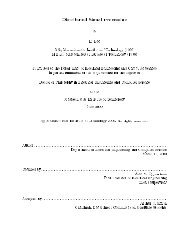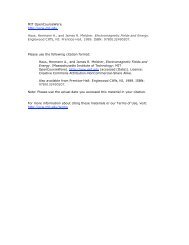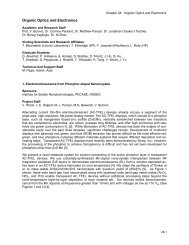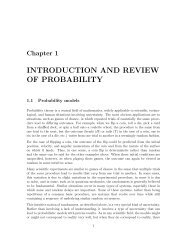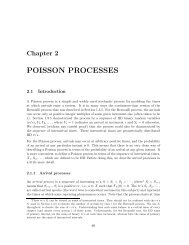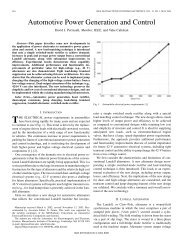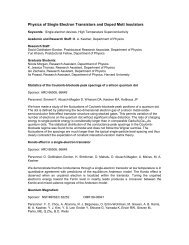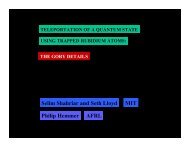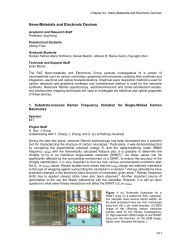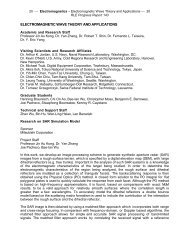RLE Progress Report No - Research Laboratory of Electronics - MIT
RLE Progress Report No - Research Laboratory of Electronics - MIT
RLE Progress Report No - Research Laboratory of Electronics - MIT
Create successful ePaper yourself
Turn your PDF publications into a flip-book with our unique Google optimized e-Paper software.
2. Saturation <strong>of</strong> Stimulated Raman Backscattering with Langmuir Decay in Five<br />
Wave Interactions<br />
Sponsors:<br />
Los Alamos National <strong>Laboratory</strong> – Grant E29060017-8F<br />
Project Staff:<br />
Ante Salcedo, Pr<strong>of</strong>essor Abraham Bers, Dr. Abhay Ram<br />
Laser stimulated Raman scattering (SRS) is an important issue for the development <strong>of</strong> inertial<br />
confinement fusion, because it strongly reduces the efficiency by driving energy away from the<br />
target. We have studied the laser stimulated Raman backscattering, in relation with recent<br />
experiments that pertain to understanding SRS in simple geometric and experimental conditions. 1<br />
The nonlinear evolution <strong>of</strong> SRS is a parametric instability, in which the laser’s electromagnetic<br />
wave (EMW) couples to both, an electron plasma wave (EPW) and a scattered electromagnetic<br />
wave, that has the largest growth rate in the backward direction (BEMW).<br />
While the nonlinear saturation <strong>of</strong> SRS can occur through several mechanisms, our model<br />
considers the saturation <strong>of</strong> SRS due to its coupling to the so-called Langmuir decay interaction<br />
(LDI), which is another kind <strong>of</strong> parametric instability. In LDI, the SRS-EPW couples to a<br />
backscattered electron plasma wave (BEPW) and an ion acoustic wave (IAW). The daughter<br />
waves <strong>of</strong> LDI had been observed in experiments, and we aim to understand the way that LDI<br />
influences the saturation <strong>of</strong> SRS.<br />
The three resonant waves in SRS, with frequencies and wave numbers: ( ω 1, k1), ( ω 2, k2<br />
) and<br />
( ω 3, k3<br />
) for the Laser, BEMW and EPW, respectively, satisfy the resonance conditions:<br />
ω<br />
1<br />
= ω2<br />
+ ω and<br />
3<br />
k<br />
1<br />
= k2<br />
+ k3<br />
. The daughter waves <strong>of</strong> LDI, on the other hand, satisfy:<br />
ω 3<br />
= ω 4<br />
+ ω and<br />
5 k<br />
3<br />
= k4<br />
+ k , where (<br />
5<br />
ω 4, k4<br />
), ( ω 5, k5<br />
), stand for the BEPW and IAW,<br />
respectively.<br />
The real frequency and wave number <strong>of</strong> each wave can be found from the approximate<br />
2 2 2 2<br />
2 2 2 2<br />
dispersion relations: ω ≈ ω pe<br />
+ c k for EMW, ω ≈ ω +<br />
2 2 2<br />
pe<br />
3vTek<br />
for EPW, and ω ≈ c s<br />
k for the<br />
IAW. In these relations, the electron temperature and density ( T<br />
e,<br />
ne<br />
) determine the plasma<br />
2 2<br />
frequency ( ω<br />
pe<br />
= q ne<br />
/ ε<br />
om<br />
), the electron thermal velocity (<br />
e<br />
v 2 Te<br />
= κT<br />
e<br />
/ m ) and the speed <strong>of</strong> sound<br />
e<br />
2<br />
in the plasma c = ZκT<br />
/ m .<br />
s<br />
e<br />
i<br />
While the collisional damping <strong>of</strong> the electromagnetic waves can be neglected, the Landau<br />
damping <strong>of</strong> longitudinal waves has to be considered. This damping is calculated from the exact<br />
EPW/IAW dispersion relation:<br />
( Z'(<br />
ζ ) Z'(<br />
ζ )<br />
e<br />
β<br />
D<br />
L<br />
k,<br />
ω)<br />
= 1−<br />
+ = 0<br />
2 2 ∑<br />
,<br />
2<br />
2k<br />
λ 2k<br />
λ<br />
2<br />
r<br />
where, λ<br />
Ds<br />
= vTs<br />
/ ω ,<br />
ps<br />
ζ s<br />
= ω / 2 | kr<br />
| v and<br />
Ts<br />
Z (ζ ) is the plasma dispersion function. The<br />
imaginary part <strong>of</strong> the frequency, ω ( ) < 0 , is the actual Landau damping.<br />
i<br />
k r<br />
De<br />
β<br />
r<br />
De<br />
1 J. Fernandez, J. A. Cobble, D. S. Montgomery, and M. D. Wilke, “Current Status <strong>of</strong> Laser-Matter Interaction <strong>Research</strong> at<br />
Los Alamos National <strong>Laboratory</strong>,” to appear in Proceedings <strong>of</strong> the XXVI European Conference on Laser Interaction with<br />
Matter (ECLIM), Prague, Czech Republic, June 12-16, 2000.



